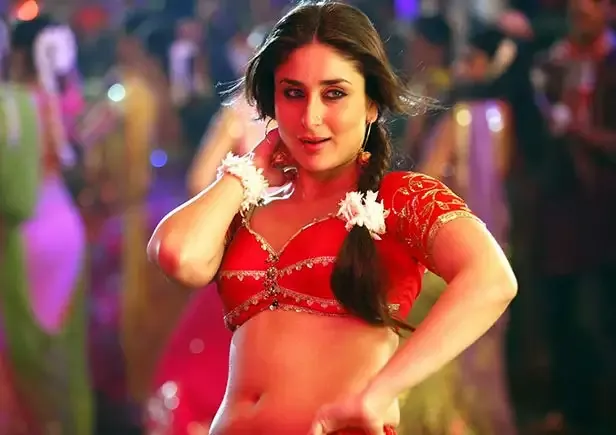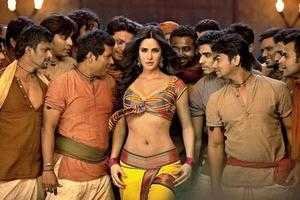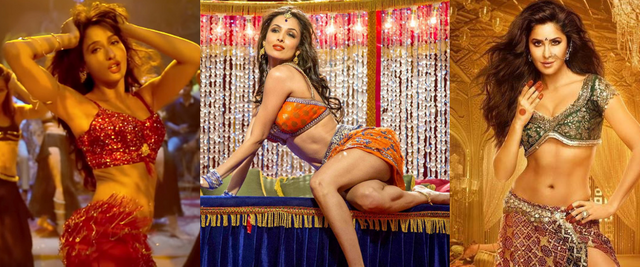
A dynamic part of Bollywood, item songs are functioning to attract Indian movie-goers as the most lucrative component for movie marketing. They are catchy, upbeat, often provocative dance and singing performances for public entertainment. The word “item” projects a woman's body as a share of consumption for the audience. It is quite often in localities, we see guys who are used to teasing women with such words as “kya Item (Maal) hain”. These songs are manifesting this degenerated public sentiment on screen. Instead of romantic love’s lure, the substances of item songs figure the female body with intoxicated seduction. And projecting the seductive nature of a woman's body is supported by the mise-en-scene, dance moves, lyrics, and camera angles. This type of song configuration has been exciting the voyeuristic desires of Indian audiences in the public sphere. We show that item girls are dancing in men's gatherings with a free flow of alcohol.
If we consider the most popular item numbers of the recent past, we see that they manifest how a woman's sexuality should be consumed as a sexual object. The lyrical formations of such songs often adopt the words from day-to-day life and metaphorically use them to delineate the seductive exposure of women's sexuality.
There are some excerpts from popular songs in the following, that clarify my point.
Munni Badnam; Dabang (2010)
“Shilpa sa figure Bebo si adaa, Bebo si adaa…..
Hai mere jhatke mein filmi mazaa re filmi mazaa”

2. Fevicol; Dabang 2 (2012)
“My gypsy with siren taiyar Bhaga le isey petrol se, petrol se petrol……
Main to tanduri, main to tanduri murgi hoon yaar Gatkale saiyan alcohol se.”

3. Chikni Chameli; Agneepath (2012)
“Haaye! baaton mein ishaara hai
Jisme khel saara hai
Tod ke tijoriyon ko loot le zara
Choom ke zakhmo pe thoda malham lagaane aayi
Husn ki teeli se beedi chillam jalaane aayi”
Identically, the lustful portrayal of women's sexuality had met the excitement in outdated folk performances. Old North Indian performances like sang, nautanki, and raginis had been projecting the seductive nature of women's sexuality from the perspective of social mockery. A large male gathering was the regular attendees of these performances. Public mockery of a woman with her lover, who wasn’t her husband, was a part of the entertainment. These performances used to ridicule immoral relationships between Mami (maternal aunt) and Bhanja (nephew), Chachi (aunt) and bhatija (nephew), bhabi (sister-in-law) and bhaiya (brother-in-law); and mocked the lusty nature of stepmother. The illustration of this sexually detrimental womanhood indicates the patriarchal mentality towards the need to control the women in society.

Eventually, the exposition of women's sexuality has adopted the new medium of technology for public entertainment over the last century. Nautankis, especially the Kanpur-based groups, became more inclined towards lewdness and vulgarism, and gradually lost their audiences to the popularity of films. Most of the nautanki groups disappeared during the second half of the 20th century. Audiences have changed, and surviving women nautanki performers danced in Bollywood songs to satisfy their audiences.
However, women's performances in front of public gatherings were a social taboo before the 20th century. And later, the sensual overtone of nautanki dancers were often considered a sexual component by society. The cinematic adoption of Hira Bai in the movie Teesri Kasam (1966) from Phanishwarnath Renu's Maare Gaye Gulfam displays a clash of personal mental state and social status of a nautanki dancer. There were many instances when locally powerful men often took women dancers to their places, as landlord Thakur Vikram Singh approached Hira bai to take her to his place in Teesri Kasam.
In the present depiction of Bollywood, item-dancers are seen performing in front of male gatherings and thereby objectifying the manifestation of the male gaze towards women's sexuality. Yet, the label 'item-number' appeared first in the late 1990s with the song “Main Aayi hoon UP Bihar lootne” from the movie Shool (1999). The recent generation of Bollywood displays the excessive mode of consumption of women's sexuality with A-list stars performing item numbers. And their appearances are usually limited to singing a song and dancing in front of a lewd male crowd. Popular item numbers of the recent past, “Kajra re” (in Bunty aur Babli), “Munni Badman” (in Dabangg), “Chikni Chameli” (in Agneepath), “fevicol se” (in Dabangg 2), “Laila mein Laila” (in Raees), “O Antava oo oo Antava” (in Pushpa), have picturized item girls only come to perform before a male gathering. Their significance for the story is limited to a dance performance at a men's party. Movies often show the presence of item girls in a dance number, the characters of Billo in Omkara (played by Bipasha Basu), Chand Baby in Ishaqzaade (played by Gauahar Khan), Anaarkali in Anaarkali of Aarah (played by Swara Bhaskar) are some of the Bollywood personifications of real-life dancers in recent times. Narratives of these movies have shown that they have objectified sexuality in the eyes of society, and their profession of dancing has made their lives more hazardous and disrespectful.
Today, numerous agencies are operating all over South Asia to provide female dancers for private parties or wedding parties from villages to cities. Item numbers are the essential part of their performances to entertain the audience. A twenty-seven-year-old female dancer recounts her experience of thirteen years of a dancing career in a private conversation. She explained how she had to experience social negligence for her profession. She says people think we have an entertaining life, and our only work is to entertain the public, but they are not concerned about our emotions. When we return home late-night, the neighbors think we are involved in an illicit business. People think we casually drink and smoke with everyone because we attend parties.
She expressed her resentment at those family members who are used to visiting bars and discos and consuming alcohol but criticized performers like her who dance professionally. She said people often look at them with their stereotypical mindset and always blame their profession for their marital and family disturbances in their private lives. Countless anonymous women like her face tremendous social pressure for their dancing profession, yet they are continuously entertaining audiences. Bollywood often hires them as back dancers but practically remains silent about their plight. The influence of Bollywood dance numbers on the lives of Indian dancers is overwhelming, and they keep dancing because of their undoubted dedication to their profession. The dancer whom I interviewed is an adherent follower of Madhuri Dixit since her childhood. She says to her friends that she loves dancing so much that she can dance at a funeral if someone plays music there.
Author’s Biographical Note: Rohit Roy is a Ph.D. scholar at the Department of History, Visva Bharati, Santiniketan. For his thesis, he is working on "Crime in Indian Society and Indian Cinema". He recently joined Explore Screen.
For more such stories do visit the website https://explorescreen.com/